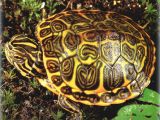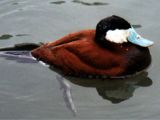When in the 50's the British first released American ruddy ducks (Oxyura jamaicensis) onto their ponds in southeast England, they did not suspect the ecological disaster they would bring. At the same time, the Spanish biologists were intending to protect the last individuals of the ruddy's European relatives, the white-headed duck (O. leucocephala).
The white headed duck nests only in Spain, Danube Delta, and Central Asia. A massive campaign against the hunt of this species, and also buying the lagoons in which the last individuals persisted gave results. But after that the ruddy ducks 'interfered': the British individuals spent the winter in Spain.
The ruddy duck males are more aggressive (and probably more attractive) than the male of white-headed duck males, and they started outcompeting them in reproduction, resulting a lot of hybrids, and a severe decline of an already endangered species.
The British government decided to kill the 6,000 population of exotic ruddy ducks, but, surprisingly (or not?, because nowadays, all types of ignorants claim they're advocates pf animal protection), Animal Aid mobilized in the favor of the ruddy duck, a menace for a native European species.
From southern/western Europe to the Great Lakes of North America, the world experienced the zebra mussel invasion. This mussel originated in Eastern European rivers flowing into the Black and Caspian Seas, and invaded in the '80s the Great Lakes in North America.
Without natural enemies, it bloomed uncontrolled and massively, so much so that it has caused damages of millions of dollars by obstructing water entrance tubes and covering boats, docks and bridges. The foreign species also displaced the native ones. This mussel adheres easily to the hull of the ships, traveling this way large distances.
There are also other 26 European species of animals (like the crab Carcinus maenas) which flourished in the New World, in the absence of parasites and diseases left on the Old World, turning into pests. Bringing their parasites also can be dangerous, as it can expose to even more severe menaces the local fauna.
The America paid back with numerous species. Generally, the North American species seems to outcompete the European ones. This is the case with the American beaver that dislocated populations of European beaver. The American mink (Mustela vison) escaped from fur farms adapted to the European ground, removing the smaller and more timid European mink (Mustela lutreola).
In 1974, the red swamp crayfish (Procambarus clarkii) was introduced from southeastern US into Europe. This species carries a water mould, Aphanomyces, to which it is immune, but at the contact with which, the indigenous crayfish of Europe, Astacus and Austropotamobius, die in a few weeks. This way, the American crayfish eliminated countless populations of European crayfish.
While the local species eat mainly detritus (organic wastes), keeping a clean water environment, the red one wipes out everything: eggs, hatchlings, algae; it also digs deeper into the banks, causing erosion. Moreover, the red crayfish results tasteless for the European consumers, which are losing this way also a valuable commercial species.
(The same happened with the Chinese carps in Mississippi ecosystems, where they displaced valuable local species.)
Perhaps the most infamous species is the Colorado potato beetle (Leptinotarsa decemlineata). The corn rootworm (Diabrotica virgifera), an American beetle, detected in 1990 in Serbia, started to devastate European corn fields.
The lack of knowledge makes many release undesired pets into the natural environments, where they can provoke disasters. The problem of the Asian pythons released in Everglades is well known. In southern Europe, the Forida River Cooter (Pseudemys floridanus) not only reproduce, but as they are more aggressive, adaptable, voracious than the European species, they have already started to replace the menaced European Emys and Mauremys terrapins.
In Spain, the local fish fauna is devastated by the introduced northern pike (Esox lucius) and Wels catfish (Silurus glanis).
Plants can be equally aggressive. Ice Plant, Hottentot Fig, or Pigface(Carpobrotus edulis), an ornamental plant from South Africa, is now invading all the Mediterranean coast, replacing local species due to its resistance to drought. Pampas grass (Cortaderia selloana), also an ornamental grass than can grow up to 3 m (10 ft) tall now forms the landscape on the western European shore, like northern Spain.
And the Mediterranean flora is menaced also underwater: Caulerpa taxifolia, the killer algae, a tropical decorative species, escaped from aquariums, but besides vivid color, it has also resistance, adaptability and great reproductive ability (when ripped, each fragment forms a new individual), the right requirements for the perfect invader. None knows where he escaped from, even if the main suspect is the Aquarium of Monaco.
It substitutes the local algae, but because it is toxic, fish cannot eat it, and this way the food chain is stopped.
It is believed that worldwide, 39 % of the animal extinctions since 1600 are due to introduction of exotic species. It's enough to think on the hordes of dogs, cats, rats and other animals released by man on the islands, where they wiped out whole local faunas. Goats and rabbits did this with the flora. For example, in Spain there are 50 established exotic vertebrate species, representing 7 % of the overall vertebrate fauna.

 14 DAY TRIAL //
14 DAY TRIAL // 


